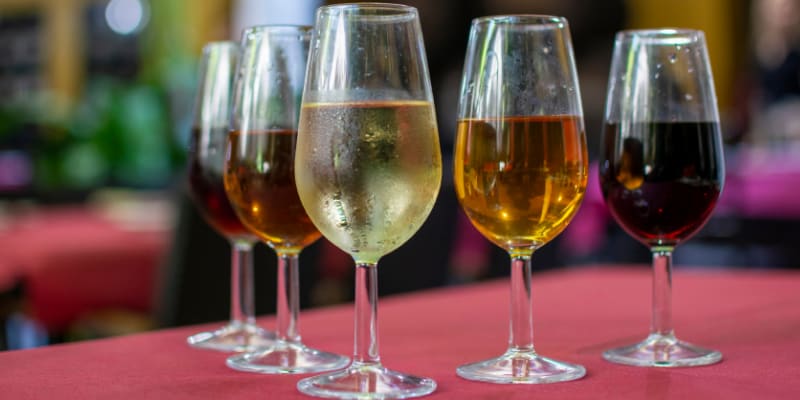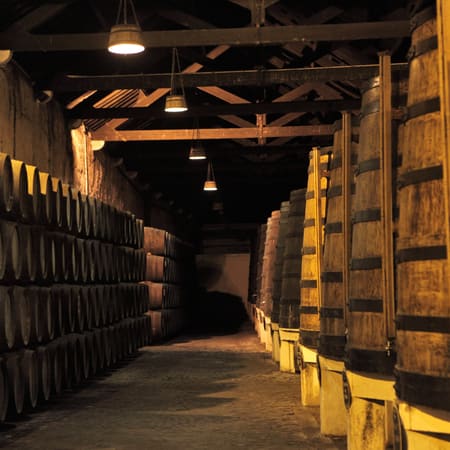Wine
Fortified Wine 101 | A Guide for Wine Lovers
August 6, 2025

Although fortified wines are baselessly dismissed by many wine consumers today, those in the know are no stranger to the captivating and sophisticated moments that these thought-provoking bottles can offer—and when stored properly, their delights can go on for decades, enhancing their complexity tenfold. The impressive longevity and distinct flavor profiles associated with fortified wines are attributed to their production process, which incorporates the addition of a distilled spirit. This addition amplifies both the flavor and concentration in the final wines, as well as adds to their ageworthy potential, making them a remarkable addition to serious cellars.
From the sweet and nutty notes of Port to the dry and crisp character of Fino Sherry, fortified wines cater to a wide range of palates. Whether enjoyed as an aperitif or paired with decadent desserts, fortified wines have the power to transform any wine drinking experience into a memorable one—though understanding the categories, regions, and a bit of the who behind it all is key. Curious to learn more? Let our experts lead the way (and be sure to check out our three curated bottle recs below!)
Types of Fortified Wines

Port
Hailing from Portugal, Port is a sweet, red fortified wine that is often enjoyed as a dessert wine. Ruby, Tawny, and vintage are among the most well-known styles of Port, each with its own distinct aging process and flavor profile. Ruby Port boasts a fruity, youthful character, while Tawny Port is known for its nutty, caramel notes developed through extended aging. Vintage Port, made from the best grapes of a single vintage, is renowned for its complexity and longevity.
“Port is named after the city of Oporto in Northern Portugal where the warehouses from the wineries kept the wines that were actually made inland in the Douro Valley,” Arias explains.
Arias notes that most Port wines are made from the indigenous grapes of Touriga Nacional, Touriga Franca, and Tinta Barroca, and that the wines can range from dry to very sweet in flavor. “This region was established and has been protected since 1756,” he says, rendering it the first demarcated wine region in the world (yes, even before those in France and Italy!)

Sherry
Originating from the Andalusia region of Spain, Sherry comes in a range of styles, from the bone-dry Fino to the lusciously sweet Pedro Ximénez. Arias reveals that Jerez-Xérès-Sherry is the official name of the Denomination of Origin of the area, and that Sherry can only be made in the "sherry triangle," which is located between the towns of Jerez de la Frontera, Puerto de Santa Maria, and Sanlúcar de Barrameda.
“Sherry wines are mostly made from grapes called Palomino Fino, Moscatel, and Pedro Ximenez,” he says. “You can find anything from very dry to extremely sweet versions of Sherry.”
For example, Fino Sherry, which is aged under a layer of yeast called flor, is light and crisp with a distinctive nutty flavor. Amontillado and Oloroso Sherries are darker and richer, having undergone oxidative aging. These Sherries offer a complex array of flavors, including toasted nuts, caramel, and dried fruits.

Madeira
Produced on the Portuguese Madeira Islands, Madeira is a fortified wine known for its exceptional longevity and unique flavor profile. “Madeira is made from the Malvasia, Bual, Sercial and Verdelho varieties,” says Arias, citing that these grapes are pretty hard to find outside of this particular area of Portugal.
Post-vinification, Madeira wines are heated during the aging process, which imparts a distinctive caramel-like taste on the final wines. Madeira comes in a range of sweetness levels, from dry to sweet, and is often enjoyed as an aperitif or paired with desserts. “Fun fact: Madeira was the wine used to cheers when the Declaration of Independence was signed!” Arais reveals.
Other notable fortified wines include Marsala from Sicily, known for its use in cooking, and Vermouth, an aromatized fortified wine that is a key ingredient in many classic cocktails (and is equally delicious when enjoyed on its own over ice!)
Sommsation Expert-Approved Fortified Wines
YAO MING Home Port Dessert Wine 2017 (Napa Valley, California) - $75.00 - The nose is succulent and shows layers of fruit flavors. Blueberry, rich strawberry and red currant notes are apparent. Soft notes of vanilla and violet and toast provide aromatic richness.
NYSA Vineyard NV Arete Dessert Wine - Half Bottle (Dundee Hills, Oregon) - $45.00 - This Port-style dessert wine has flavors and aromas of nuttiness, honey and toffee.
Clif Family Winery Petite Sirah Dessert Wine - Half Bottle (Napa Valley, California) - $45.00 - Like a hot fudge brownie sundae oozing with caramel topping, this fortified dessert wine also offers aromas of blackberry pie and smoke meats. The thick, chewy and long palate has richness that is sure to impress
Historical Context

The history of fortified wines is closely tied to the seafaring trade of the 16th and 17th centuries. During this time, wine was often spoiled during long sea voyages due to exposure to heat and air. The addition of distilled spirits to the wine was found to prevent spoilage, allowing the wines to survive the journey and even improve in flavor over time.
This discovery led to the development of fortified wines in various regions, each with its own unique traditions and techniques. Port, for example, gained popularity in England after the 1703 Methuen Treaty, which granted favorable trade terms to Portuguese wines. Sherry, on the other hand, became a beloved drink among the British aristocracy, with the town of Jerez de la Frontera becoming a hub for Sherry production.
Today, fortified wines continue to play an important role in the wine traditions of countries like Portugal, Spain, and Italy. They are protected by strict regulations that ensure the quality and authenticity of each style, preserving the rich history and cultural significance of these wines.
Production Process
Fortification
Fortification is the process of adding a distilled spirit, usually brandy, to the wine. This addition can occur either during or after fermentation, depending on the desired level of sweetness. For example, in the production of Port, the spirit is added during fermentation to halt the process and preserve some of the natural grape sugars, resulting in a sweeter wine. In contrast, Sherry is fortified after fermentation, allowing the wine to remain dry.
The addition of the spirit also increases the alcohol content of the wine, typically reaching between 15% to 22% ABV. This higher alcohol content not only contributes to the wine's stability but also influences its flavor profile and mouthfeel.
Aging
Aging plays a crucial role in the development of a fortified wine's complex flavors and aromas. Many fortified wines, such as Tawny Port and Madeira, are aged oxidatively, meaning they are exposed to oxygen during the aging process. This exposure leads to the development of nutty, caramel-like flavors and a darker color.
In the production of Sherry, the solera system is employed. This unique aging method involves blending wines from different vintages, with younger wines added to barrels containing older wines. This process ensures consistency and complexity in the final product, as the average age of the wine increases over time.
The aging period varies depending on the type and style of fortified wine. Some styles, like Ruby Port, are aged for a relatively short period, while others, such as Vintage Port and certain Madeiras, can age for decades or even centuries.

Uses and Pairing
In the culinary world, fortified wines are prized for their ability to add depth and complexity to dishes. Sherry, for instance, is a common ingredient in soups, stews, and sauces, imparting a rich, savory flavor. Port and Madeira are often used in desserts, such as chocolate cakes or fruit tarts, to enhance the sweetness and provide a luxurious mouthfeel.
“Due to the variety of styles of fortified wine available, the pairings are very broad,” says Arias, citing that dry expressions are perfect with seafood and vegetables, while sweeter versions are a match made in heaven with strong cheeses and desserts. For example, the sweetness and richness of Port make it an excellent companion to blue cheeses and dark chocolate, while the nuttiness and complexity of Sherry pair beautifully with olives, cured meats, and aged cheeses. Madeira's caramel notes complement rich, nutty desserts like pecan pie or crème brûlée.
Fortified wines also play a significant role in the world of cocktails. Vermouth, in particular, is a key ingredient in many classic cocktails, such as the Martini, Manhattan, and Negroni. The botanical flavors and aromas of Vermouth add depth and complexity to these drinks, elevating them beyond simple spirit-based cocktails.

Fortified Wines on the Market Today
Despite their long history and cultural significance, fortified wines have faced challenges in recent years. Market trends have shifted, with many consumers opting for lighter, fresher styles of wine. However, the craft cocktail movement has helped to reignite interest in fortified wines, particularly Vermouth, as bartenders and consumers alike seek out high-quality, artisanal ingredients.
Best of all, Arias reveals that well-made fortified wines can last for decades—and at times, even over a century. “Depending on the style, some fortified wines will last 25-30 years, but other expressions can last a lot longer due to the high alcohol content and the way they were produced,” he says. As an example, Arias shares that the oldest bottle of Madeira that he’s ever tasted was from 1875—”and it was still very delicious!” he exclaims.
Sommsation Expert-Approved Fortified Wines
YAO MING Home Port Dessert Wine 2017 (Napa Valley, California) - $75.00 - The nose is succulent and shows layers of fruit flavors. Blueberry, rich strawberry and red currant notes are apparent. Soft notes of vanilla and violet and toast provide aromatic richness.
NYSA Vineyard NV Arete Dessert Wine - Half Bottle (Dundee Hills, Oregon) - $45.00 - This Port-style dessert wine has flavors and aromas of nuttiness, honey and toffee.
Clif Family Winery Petite Sirah Dessert Wine - Half Bottle (Napa Valley, California) - $45.00 - Like a hot fudge brownie sundae oozing with caramel topping, this fortified dessert wine also offers aromas of blackberry pie and smoke meats. The thick, chewy and long palate has richness that is sure to impress.
Whether you are a seasoned wine enthusiast or a curious newcomer, fortified wines offer a wealth of flavors, aromas, and experiences waiting to be discovered. For a deeper dive into these special bottlings, book a personalized wine tasting experience or browse our curated selections today.
